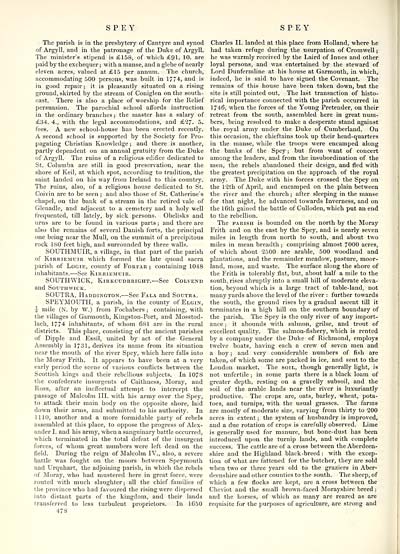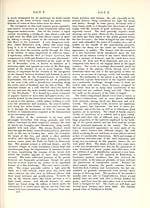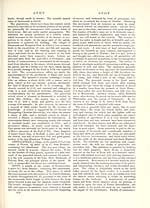Topographical dictionary of Scotland > Volume 2
(486) Page 478
Download files
Complete book:
Individual page:
Thumbnail gallery: Grid view | List view

SPEY
S PE Y
The parish is in the presbytery of Cantyre and synod
of Argyll, and in the patronage of the Duke of Argyll.
The minister's stipend is £158, of which £91. 10. are
paid by the exchequer; with a manse, and a glebe of nearly
eleven acres, valued at £15 per annum. The church,
accommodating 500 persons, was built in 1774, and is
in good repair ; it is pleasantly situated on a rising
ground, skirted by the stream of Coniglen on the south-
east. There is also a place of worship for the Relief
persuasion. The parochial school affords instruction
in the ordinary branches ; the master has a salary of
£34. 4., with the legal accommodations, and £27- 5.
fees. A new school-house has been erected recently.
A second school is supported by the Society for Pro-
pagating Christian Knowledge ; and there is another,
partly dependent on an annual gratuity from the Duke
of Argyll. The ruins of a religious edifice dedicated to
St. Columba are still in good preservation, near the
shore of Keil, at which spot, according to tradition, the
saint landed on his way from Ireland to this country.
The ruins, also, of a religious house dedicated to St.
Coivin are to be seen ; and also those of St. Catherine's
chapel, on the bank of a stream in the retired vale of
Glenadle, and adjacent to a cemetery and a holy well
frequented, till lately, by sick persons. Obelisks and
urns are to be found in various parts ; and there are
also the remains of several Danish forts, the principal
one being near the Mull, on the summit of a precipitous
rock 180 feet high, and surrounded by three walls.
SOUTHMUIR, a village, in that part of the parish
of Kirriemuir which formed the late quoad sacra
parish of Logie, county of Forfar ; containing 104S
inhabitants. — -See Kirriemuir.
SOUTHWICK, Kirkcudbright. — See Colvend
and Southwick.
SOUTRA, Haddington. — See Fala and Soutra.
SPEYMOUTH, a parish, in the county of Elgin,
J mile (N. by W.) from Fochabers ; containing, with
the villages of Garmouth, Kingston-Port, and Mosstod-
lach, 1774 inhabitants, of whom 681 are in the rural
districts. This place, consisting of the ancient parishes
of Dipple and Essil, united by act of the General
Assembly in 1731, derives its name from its situation
near the mouth of the river Spey, which here falls into
the Moray Frith. It appears to have been at a very
early period the scene of various conflicts between the
Scottish kings and their rebellious subjects. In 1078
the confederate insurgents of Caithness, Moray, and
Ross, after an ineffectual attempt to intercept the
passage of Malcolm III. with his army over the Spey,
to attack their main body on the opposite shore, laid
down their arms, and submitted to his authority. In
1110, another and a more formidable party of rebels
assembled at this place, to oppose the progress of Alex-
ander I. and his army, when a sanguinary battle occurred,
which terminated in the total defeat of the insurgent
forces, of whom great numbers were left dead on the
field. During the reign of Malcolm IV., also, a severe
battle was fought on the moors between Speymouth
and Urquhart, the adjoining parish, in which the rebels
of Moray, who had mustered here in great force, were
routed with much slaughter; all the chief families of
the province who had favoured the rising were dispersed
into distant parts of the kingdom, and their lands
transferred to less turbulent proprietors. In 1650
478
Charles II. landed at this place from Holland, where he
had taken refuge during the usurpation of Cromwell ;
he was warmly received by the Laird of Innes and other
loyal persons, and was entertained by the steward of
Lord Dunfermline at his house at Garmouth, in which,
indeed, he is said to have signed the Covenant. The
remains of this house have been taken down, but the
site is still pointed out. The last transaction of histo-
rical importance connected with the parish occurred in
1746, when the forces of the Young Pretender, on their
retreat from the south, assembled here in great num-
bers, being resolved to make a desperate stand against
the royal army under the Duke of Cumberland. On
this occasion, the chieftains took up their head-quarters
in the manse, while the troops were encamped along
the banks of the Spey ; but from want of concert
among the leaders, and from the insubordination of the
men, the rebels abandoned their design, and fled with
the greatest precipitation on the approach of the royal
army. The Duke with his forces crossed the Spey on
the 12th of April, and encamped on the plain between
the river and the church ; after sleeping in the manse
for that night, he advanced towards Inverness, and on
the 16th gained the battle of Culloden, which put an end
to the rebellion.
The parish is bounded on the north by the Moray
Frith and on the east by the Spey, and is nearly seven
miles in length from north to south, and about two
miles in mean breadth ; comprising almost 7000 acres,
of which about 2500 are arable, 500 woodland and
plantations, and the remainder meadow, pasture, moor-
land, moss, and waste. The surface along the shore of
the Frith is tolerably flat, but, about half a mile to the
south, rises abruptly into a small hill of moderate eleva-
tion, beyond which is a large tract of table-land, not
many yards above the level of the river : further towards
the south, the ground rises by a gradual ascent till it
terminates in a high hill on the southern boundary of
the parish. The Spey is the only river of any import-
ance ; it abounds with salmon, grilse, and trout of
excellent quality. The salmon-fishery, which is rented
by a company under the Duke of Richmond, employs
twelve boats, having each a crew of seven men and
a boy ; and very considerable numbers of fish are
taken, of which some are packed in ice, and sent to the
London market. The soil, though generally light, is
not unfertile ; in some parts there is a black loam of
greater depth, resting on a gravelly subsoil, and the
soil of the arable lands near the river is luxuriantly
productive. The crops are, oats, barley, wheat, pota-
toes, and turnips, with the usual grasses. The farms
are mostly of moderate size, varying from thirty to 200
acres in extent ; the system of husbandry is improved,
and a due rotation of crops is carefully observed. Lime
is generally used for manure, but bone-dust has been
introduced upon the turnip lands, and with complete
success. The cattle are of a cross between the Aberdeen-
shire and the Highland black-breed : with the excep-
tion of what are fattened for the butcher, they are sold
when two or three years old to the graziers in Aber-
deenshire and other counties to the south. The sheep, of
which a few flocks are kept, are a cross between the
Cheviot and the small brown-faced Morayshire breed ;
and the horses, of which as many are reared as are
requisite for the purposes of agriculture, are strong and
S PE Y
The parish is in the presbytery of Cantyre and synod
of Argyll, and in the patronage of the Duke of Argyll.
The minister's stipend is £158, of which £91. 10. are
paid by the exchequer; with a manse, and a glebe of nearly
eleven acres, valued at £15 per annum. The church,
accommodating 500 persons, was built in 1774, and is
in good repair ; it is pleasantly situated on a rising
ground, skirted by the stream of Coniglen on the south-
east. There is also a place of worship for the Relief
persuasion. The parochial school affords instruction
in the ordinary branches ; the master has a salary of
£34. 4., with the legal accommodations, and £27- 5.
fees. A new school-house has been erected recently.
A second school is supported by the Society for Pro-
pagating Christian Knowledge ; and there is another,
partly dependent on an annual gratuity from the Duke
of Argyll. The ruins of a religious edifice dedicated to
St. Columba are still in good preservation, near the
shore of Keil, at which spot, according to tradition, the
saint landed on his way from Ireland to this country.
The ruins, also, of a religious house dedicated to St.
Coivin are to be seen ; and also those of St. Catherine's
chapel, on the bank of a stream in the retired vale of
Glenadle, and adjacent to a cemetery and a holy well
frequented, till lately, by sick persons. Obelisks and
urns are to be found in various parts ; and there are
also the remains of several Danish forts, the principal
one being near the Mull, on the summit of a precipitous
rock 180 feet high, and surrounded by three walls.
SOUTHMUIR, a village, in that part of the parish
of Kirriemuir which formed the late quoad sacra
parish of Logie, county of Forfar ; containing 104S
inhabitants. — -See Kirriemuir.
SOUTHWICK, Kirkcudbright. — See Colvend
and Southwick.
SOUTRA, Haddington. — See Fala and Soutra.
SPEYMOUTH, a parish, in the county of Elgin,
J mile (N. by W.) from Fochabers ; containing, with
the villages of Garmouth, Kingston-Port, and Mosstod-
lach, 1774 inhabitants, of whom 681 are in the rural
districts. This place, consisting of the ancient parishes
of Dipple and Essil, united by act of the General
Assembly in 1731, derives its name from its situation
near the mouth of the river Spey, which here falls into
the Moray Frith. It appears to have been at a very
early period the scene of various conflicts between the
Scottish kings and their rebellious subjects. In 1078
the confederate insurgents of Caithness, Moray, and
Ross, after an ineffectual attempt to intercept the
passage of Malcolm III. with his army over the Spey,
to attack their main body on the opposite shore, laid
down their arms, and submitted to his authority. In
1110, another and a more formidable party of rebels
assembled at this place, to oppose the progress of Alex-
ander I. and his army, when a sanguinary battle occurred,
which terminated in the total defeat of the insurgent
forces, of whom great numbers were left dead on the
field. During the reign of Malcolm IV., also, a severe
battle was fought on the moors between Speymouth
and Urquhart, the adjoining parish, in which the rebels
of Moray, who had mustered here in great force, were
routed with much slaughter; all the chief families of
the province who had favoured the rising were dispersed
into distant parts of the kingdom, and their lands
transferred to less turbulent proprietors. In 1650
478
Charles II. landed at this place from Holland, where he
had taken refuge during the usurpation of Cromwell ;
he was warmly received by the Laird of Innes and other
loyal persons, and was entertained by the steward of
Lord Dunfermline at his house at Garmouth, in which,
indeed, he is said to have signed the Covenant. The
remains of this house have been taken down, but the
site is still pointed out. The last transaction of histo-
rical importance connected with the parish occurred in
1746, when the forces of the Young Pretender, on their
retreat from the south, assembled here in great num-
bers, being resolved to make a desperate stand against
the royal army under the Duke of Cumberland. On
this occasion, the chieftains took up their head-quarters
in the manse, while the troops were encamped along
the banks of the Spey ; but from want of concert
among the leaders, and from the insubordination of the
men, the rebels abandoned their design, and fled with
the greatest precipitation on the approach of the royal
army. The Duke with his forces crossed the Spey on
the 12th of April, and encamped on the plain between
the river and the church ; after sleeping in the manse
for that night, he advanced towards Inverness, and on
the 16th gained the battle of Culloden, which put an end
to the rebellion.
The parish is bounded on the north by the Moray
Frith and on the east by the Spey, and is nearly seven
miles in length from north to south, and about two
miles in mean breadth ; comprising almost 7000 acres,
of which about 2500 are arable, 500 woodland and
plantations, and the remainder meadow, pasture, moor-
land, moss, and waste. The surface along the shore of
the Frith is tolerably flat, but, about half a mile to the
south, rises abruptly into a small hill of moderate eleva-
tion, beyond which is a large tract of table-land, not
many yards above the level of the river : further towards
the south, the ground rises by a gradual ascent till it
terminates in a high hill on the southern boundary of
the parish. The Spey is the only river of any import-
ance ; it abounds with salmon, grilse, and trout of
excellent quality. The salmon-fishery, which is rented
by a company under the Duke of Richmond, employs
twelve boats, having each a crew of seven men and
a boy ; and very considerable numbers of fish are
taken, of which some are packed in ice, and sent to the
London market. The soil, though generally light, is
not unfertile ; in some parts there is a black loam of
greater depth, resting on a gravelly subsoil, and the
soil of the arable lands near the river is luxuriantly
productive. The crops are, oats, barley, wheat, pota-
toes, and turnips, with the usual grasses. The farms
are mostly of moderate size, varying from thirty to 200
acres in extent ; the system of husbandry is improved,
and a due rotation of crops is carefully observed. Lime
is generally used for manure, but bone-dust has been
introduced upon the turnip lands, and with complete
success. The cattle are of a cross between the Aberdeen-
shire and the Highland black-breed : with the excep-
tion of what are fattened for the butcher, they are sold
when two or three years old to the graziers in Aber-
deenshire and other counties to the south. The sheep, of
which a few flocks are kept, are a cross between the
Cheviot and the small brown-faced Morayshire breed ;
and the horses, of which as many are reared as are
requisite for the purposes of agriculture, are strong and
Set display mode to: Large image | Transcription
Images and transcriptions on this page, including medium image downloads, may be used under the Creative Commons Attribution 4.0 International Licence unless otherwise stated. ![]()
| Gazetteers of Scotland, 1803-1901 > Topographical dictionary of Scotland > Volume 2 > (486) Page 478 |
|---|
| Permanent URL | https://digital.nls.uk/97366962 |
|---|
| Description | Volume II: From Keanlochbervie to Zetland. |
|---|---|
| Attribution and copyright: |
|

